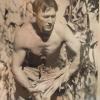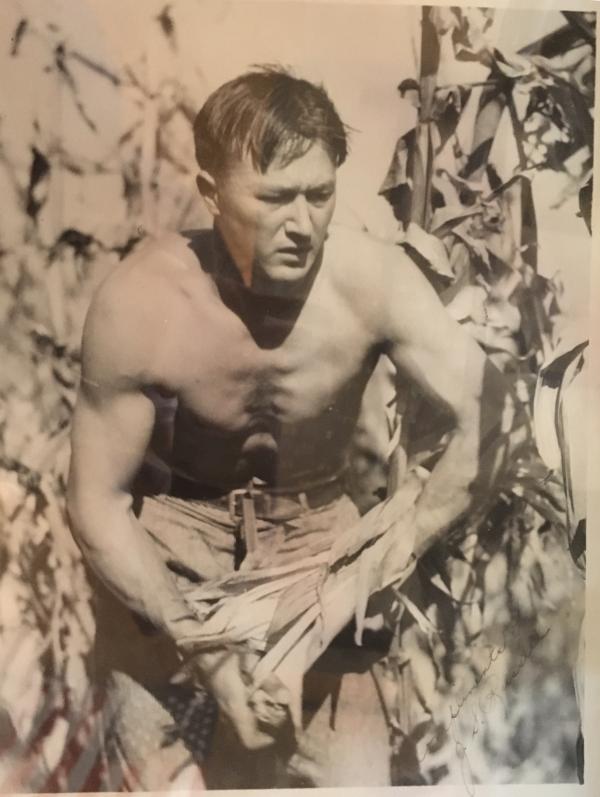Advancement in Agriculture
| Grade | 9th -12th Grades | Class | U.S. History | Length of Lesson | 1 class period |
| Lesson Title | Advancement in Agriculture |
| Unit Title | |
| Unit Compelling Question | How have influential Americans and inventors affected early American industry (civil war to WWII)? |
| Historical Context: This photograph, in the collection of the Audubon County Historical Society, shows farmer Elmer G. Carlson of Audubon, Iowa. During the 1930s, Carlson participated in corn husking competitions across the Midwest. In each of these competitions, Carlson husked corn without a shirt on. In 1935, Carlson won the National Corn Husking Championship held in Attica, Indiana. In addition to competing as a corn husker, Carlson founded the Carlson Hybrid Seed Corn Company. He named his brand of seed corn "Carlson's Champion Hybrid Corn." Later in life, Carlson founded the Farmers of Iowa Inaugural Committee. As part of this committee, Carlson rented the ballroom of the International Inn in Washington D.C. for three nights in January 1977 to celebrate the inauguration of President Jimmy Carter. Thousands of people attended the parties that he held on these nights. ### The years between the Civil War and WW II saw two great transformations of Midwestern agriculture. The first was bringing the Industrial Revolution to the farm with the introduction of horse power to agricultural machinery. Hay rakes, mowers, oat binders, planters, riding cultivators (weeders) all greatly expanded one farmer's ability to manage much larger fields and to increase production. Steam engines powered threshing machines that could run more oat bundles through in one day, separate the grain from the chaff, than a farm family could thresh and winnow on the barn floor in two weeks. Farmers worked together to purchase and operate the steam engine and threshing day became an important annual event in the cycle of farm life. Beginning in the first decade of the 20th C., gasoline-powered machinery began to make an appearance on the farm. Sometimes small motors could run a water pump or power a small electrical system to bring electric lights to the farm house. Tractors were a big innovation. They did not need to rest as horses did, and because they used gasoline rather than oats, the farmer did not need to devote a field to fuel production. As they became more powerful and versatile, tractors pulled larger and larger plows, planters, and cultivators. They led to the development of corn pickers and combines that threshed grain in the field. Again, assisted by ever-greater technology, a successful farmer could expand his land holdings. The size of farms rose; the numbers of farms declined. And with that decline came a decline in the rural population with many implications for the nation. The Iowa legislature from earliest time was dominated by rural representatives because farming was far and away the largest industry. When the urban population started to grow and rural areas decline, cities started to push for greater representation. The biggest fights came after WW II but the seeds were planted with the introduction of improved farm technology. Another shirt was in education. Automobiles allowed rural students to attend town schools, including high school, and one-room schools saw a sharp decline. Rural churches and the smallest towns also struggled to stay open. However, for the farm family, technology brought some distinct advantages. Telephones, rural free postal delivery, and radios reduced the isolation that farm families felt. Better roads and road graders helped farm families avoid the isolation of deep springtime mud and winter drifts. The Extension Service provided information about good farming and homemaking practices for adults and 4-H clubs to farm youth. The eight decades between the Civil War and WW II saw a roller coaster in farm prices and radical changes in rural life. There were advantages to the farm families that survived the shake-down, but there were also some losses that came with the labor-saving machinery because the labor that was saved was the livelihood of neighbors. |
|
| Lesson Supporting Question | |
| Lesson Overview | Students will analyze and evaluate how Iowa and its people helped to make advancements in agriculture, and how this could affect industries. |
| Primary Sources Used |
|
| Resources Needed | |
| Standard | |
| Lesson Target | Students will understand how Iowa has been affected by new agricultural influences.;Students will understand how Iowans help to bring about new agricultural influences.;Students will know... |
| Lesson Themes | Science & Technology of Ag |
|
| Formative Assessment (How will you use the formative assessments to monitor and inform instruction?) |
Students will have a short answer essay quiz., Group discussion - will have time to share thoughts and discuss assignment in small groups, and then share to the teacher and class. |
| Summative Assessment (How does the lesson connect to planned summative assessment(s)?) |
Students will be given a handout and asked to use the internet to complete a web quest on agricultural advancement sand influential Iowans, students should go to http://www.iptv.org/iowapathways. Students should completely and fully answer all of the following questions on the handout. Once they have completed the hand out they will in groups of four, and share things 2 things they found interesting and discuss how Iowa might be different if we didn’t have these inventions, and how that would affect Iowa’s industry. Then each group will share their ideas of what they think Iowa would be like if we didn’t have these people or inventions to help us. They will have the majority of class to do the web quest and the last ten minutes will be saved for discussion. |
| Author | Anna Kahle | Created | Last Edited | ||||
| Reviewer: Dr. Lisa Millsaps, University of Northern Iowa | |||||||
| Lesson Plan Development Notes: Teaching Methods, University of Northern Iowa, Fall 2018 | |||||||


